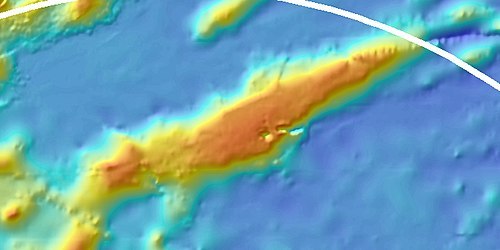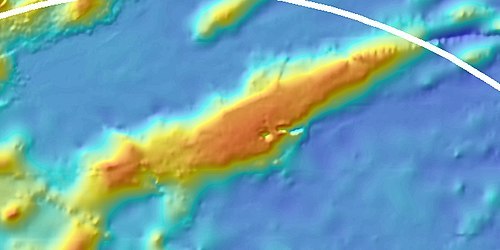#guyot environment
Text
Just a quick note to followers, although I am following The Ocean Race, I likely won’t be blogging about it. There is only so many hours in the day!
Frankly, using the IMOCA foils in the Southern Ocean on a super LONG leg seems to me a recipe for disaster because the ability to slow down and not speed up is key.
Talk about alarms ringing and being in continual crisis management on the boats. Thank g*d they are using an autopilot to steer the boats, because the crews have enough to contend with…And let’s not talk about difficulties eating, drinking, being sea sick while attending to one’s natural needs combined with the biggest sleep deficits known to sailors.
Anyway, I sincerely hope that I am wrong about this iteration of The Ocean Race. Especially since they have announced that the IMOCAs will be used for the next iteration of the The Ocean Race and the The Ocean Race Europe as well.
NO BETS on the number of boats who will actually finish this race.
#competitive sailing#the ocean race#imocas#imoca foiling#the southern ocean#longest leg without stopping from south africa to brazil#from south africa to brazil#just a wannabe sailor with keen interest in engineering and design#biotherm#11th hour racing#guyot environment#malitzia#any of the five can win#team jajo#holcim#life at the extreme for sure#and i like extreme sports but this is beyond crazy#no bets on risking human lives#water war of attrition#50th edition better not end in disaster
4 notes
·
View notes
Text
Beneath the Waves: Exploring the Secrets of the Ocean Floor
The ocean, covering more than 70% of our planet, holds a vast and mysterious realm beneath its surface. The ocean floor, largely unexplored and enigmatic, is a fascinating frontier for scientists and researchers eager to unravel its secrets. In this blog post, we embark on a journey to discover the hidden wonders that lie beneath the waves.
The Abyssal Plains: A Submarine Desert
One of the predominant features of the ocean floor is the abyssal plain, an expansive, flat region that covers the majority of the deep ocean. Despite its seemingly barren appearance, abyssal plains are teeming with life. Strange and elusive creatures, adapted to extreme pressures and minimal light, call this underwater desert home.
Submarine Volcanoes and Hydrothermal Vents: Nature's Powerhouses
Beneath the waves, a different kind of volcanic activity shapes the ocean floor. Submarine volcanoes, often hidden from our view, create unique ecosystems around them. Hydrothermal vents, found near these volcanic structures, release mineral-rich fluids into the ocean, supporting a diverse array of life forms that thrive in the absence of sunlight.
Mysterious Underwater Mountains: Seamounts and Guyots
Rising dramatically from the ocean floor, seamounts and guyots are underwater mountains that punctuate the flatness of the abyssal plains. These geological formations provide habitats for a variety of marine species, some of which are found nowhere else on Earth. Exploring these submerged peaks unveils a world of biodiversity and geological wonders.
The Mid-Ocean Ridge: Earth's Largest Mountain Range
Stretching for thousands of miles across the ocean floor, the Mid-Ocean Ridge is the longest mountain range on our planet. This colossal underwater mountain system is a dynamic environment where tectonic plates pull apart, creating new oceanic crust. It's also home to unique creatures adapted to survive in extreme conditions, showcasing the resilience of life in Earth's most extreme environments.
Mapping the Uncharted Depths
While technology has advanced significantly, the ocean floor remains one of the least mapped areas on Earth. Cutting-edge tools like autonomous underwater vehicles and remotely operated vehicles enable scientists to explore and document the hidden landscapes beneath the waves. These technologies not only unveil the mysteries of the ocean floor but also contribute to our understanding of Earth's geology and biodiversity.
The Importance of Ocean Exploration and Conservation
As we continue to unlock the secrets of the ocean floor, it becomes increasingly evident that this mysterious realm plays a crucial role in regulating Earth's climate and supporting diverse ecosystems. Conservation efforts are essential to preserving the delicate balance of life beneath the waves, ensuring that future generations can continue to marvel at the wonders hidden in the depths of the ocean.
In conclusion, exploring the secrets of the ocean floor is a captivating journey that unveils the beauty and complexity of Earth's underwater landscapes. As technology advances and our understanding deepens, the mysteries that lie beneath the waves continue to inspire awe and curiosity, reminding us of the importance of preserving and protecting our planet's most enigmatic environments.
0 notes
Video
vimeo
Echoes Of Us: Chapter 01 from Toast on Vimeo.
Echoes Of Us explores the various ways humans have related to one another throughout history. Over the years our environments have changed, but what it means to be intrinsically human has remained the same. This is the first chapter in the series.
Directed by Toast
Creative Direction: Chris Guyot
Design and Animation: Alejandro Pérez, Chris Guyot
Executive Producer: Tyler Guyot
Sound Design: John Poon
0 notes
Text
vimeo
Concrete is an immersive experience that offers to discover digital architectures through lights and shadows that reveal the volumes and geometry of these environments. A tangible interface of concrete and electronics controls the parts of these buildings. To access the various structures, each person is invited to solve an enigma based on a pattern of light. With Concrete, I aimed to combine reflection on how we interact with a digital world with brutalist architectural inspirations and a playful experience of virtual reality.
ECAL Diploma project (2020) by Léonard Guyot
0 notes
Text




Guédelon Castle (Château de Guédelon) is a castle currently under construction near Treigny, France. The castle is the focus of an experimental archaeology project aimed at recreating a 13th-century castle and its environment using period technique, dress, and material.
In order to fully investigate the technology required in the past, the project is using only period construction techniques, tools, and costumes. Materials, including wood and stone, are all obtained locally. Jacques Moulin, chief architect for the project, designed the castle according to the architectural model developed during the 12th and 13th centuries by Philip II of France.
Construction started in 1997 under Michel Guyot, owner of Château de Saint-Fargeau, a castle in Saint-Fargeau 13 kilometres away. The site was chosen according to the availability of construction materials: an abandoned stone quarry, in a large forest, with a nearby pond.[1] The site is in a rural woodland area and the nearest town is Saint-Sauveur-en-Puisaye, about 5 kilometres (3.1 mi) to the northeast.
35 notes
·
View notes
Text
Wikipedia article of the day for October 9, 2019 -- Horizon Guyot
The Wikipedia article of the day for October 9, 2019 is Horizon Guyot.
Horizon Guyot is an underwater volcanic mountain with a flat top in the Mid-Pacific Mountains west of Hawaii and northeast of the Line Islands. An elongated ridge over 300 kilometres (190 mi) long and 4.3 kilometres (2.7 mi) high, it stretches in a northeast–southwest direction, rising to a depth of 1,443 metres (4,734 ft). It was probably formed by a hotspot, but evidence is conflicting. Its volcanic activity occurred between 100.5 and 82 million years ago during the Cretaceous Period. Around 89 million years ago, carbonate deposition from lagoonal and reefal environments set in and formed limestone. Volcanic islands developed on Horizon Guyot as well and were colonised by plants. Pelagic ooze has accumulated on the seamount, forming a thick layer that has been further modified by ocean currents, landslides, and various organisms living on it. Ferromanganese crusts have been deposited on exposed rocks.
1 note
·
View note
Text
University Health Services Building, Princeton University
University Health Services Building, Princeton University, New Jersey Architecture, USA, Images
University Health Services Building at Princeton University
Feb 18, 2022
Architects: WRNS Studio
Location: Princeton University, New Jersey, USA
University Health Services Building
WRNS Studio has been selected to design the new University Health Services (UHS) Building at Princeton University. The project is slated to transform not only service delivery but to also enhance the overall experience of community and place on campus by contributing to a “culture of wellness.” Construction is projected to be complete in 2024.
“This project will provide a tremendous, thoughtfully designed resource to students, staff, and faculty at a time when health and wellness are understood as more essential than ever,” notes Bryan Shiles, Partner, WRNS Studio.
The building’s program will accommodate counseling and psychological services; medical services (including outpatient medical, athletic medicine, global & community health, occupational health, and an overnight infirmary service); health promotion and prevention services; sexual harassment/assault advising, resources and education (SHARE) office; and quality and performance improvement area.
The heart of UHS can be understood as the central atrium connecting three distinct wings including Eno Hall, an existing laboratory building constructed in 1924. By adaptively reusing Eno Hall, UHS anchors to the rich architectural heritage of campus while allowing two contemporary wings to stretch towards Guyot Lane and Goheen Walk—two primary pedestrian pathways.
Each of the building’s three wings supports a different focus—counseling and psychological services/SHARE, urgent and outpatient medical care, and administrative/health promotion and prevention services space. As the point of embarkation to the three wings, the atrium is the connective tissue of the building, hosting a large reception lounge and serving as the main orienting device.
The project site—located at a crossroads of campus life—will be leveraged to embolden a holistic concept of student health and embed it in Princeton’s sense of place. As the project is adjacent to several centers of student life, such as Residential College dining and recreation, opportunities for cross programming are being explored to embed a culture of wellness into the heart of campus while helping various outreach programs collaborate and serve the campus more efficiently.
With wellness as a sustainable design through line, UHS is targeting LEED Gold certification and will employ a hybrid mass timber and steel structure, reducing the project’s carbon footprint while offering a warm and welcoming environment for students to obtain healthcare.
About WRNS Studio
WRNS Studio works with today’s most transformative organizations to steward their brands with exceptional architecture. Recognized for sustainable, site-specific design at any scale, WRNS Studio has offices in San Francisco, Honolulu, Seattle and New York. WRNS Studio has twice been named top firm in the U.S. by Architect magazine and have been recognized as a Fast Company 2020 Most Innovative design firm. For more information, please visit www.wrnsstudio.com
Design: WRNS Studio – https://www.wrnsstudio.com/
University Health Services Building, Princeton University images / information received 180222
Location: Princeton University, New Jersey, USA
Princeton Buildings
Princeton University Arts Buildings
Design: Steven Holl Architects
Princeton University Building
Jun 15, 2017
Embodied Computation Lab for Princeton University
Design: The Living, Architects
image courtesy of architects
Embodied Computation Lab for Princeton University
Princeton University – Chemistry Building
Hopkins Architects
Frick Chemistry Laboratory photo : Princeton University, Office of Communications, Denise Applewhite
Princeton University Chemistry Laboratory
Princeton University Arts Buildings design : Steven Holl Architects
New Jersey Buildings
Princeton University Arts Campus
Princeton House
Princeton University Art Museum Exhibition
Princeton University Art Museum Exhibition, USA : ‘Princeton and the Gothic Revival : 1870-1930’
American Architects
American Architecture
Buildings / photos for the University Health Services Building, Princeton University designed by WRNS Studio page welcome
The post University Health Services Building, Princeton University appeared first on e-architect.
0 notes
Text
The title of the movie I watched is "Geostorm". This is movie is written by Paul Guyot and Dean Devlin who is also the director of the movie. What I really liked about the Geostorm is its advance technology emphasized in the movie. How human can be extraordinary, how powerful our technology can be, that even a natural state of our climate can be controlled by human invention. Although the movie is not realistic but the idea of technologies shared in the movie which can be useful in the field of science and technology is very essential in the future. No matter how great or advance a human invention is when mother nature acts, nothing or no human force can control or prevent it from happening. Natural disasters are very dangerous that is why all of us must be responsible individual in taking care of our environment.
@meanching
1 note
·
View note
Photo

Chez Coste est une des cuvées qui sera en dégustation demain samedi 14 mars aux @caves_bardou des Ternes (169 Boulevard Pereire Paris 17). Cette cuvée parcellaire a été vieillie en amphore et présente les caractéristiques suivantes: Terroir: Coeur de parcelle de Perdriziere dite "Culture" plantée sur un sol de gorrhe, riche en manganèse. Vignes de 30 ans. Altitude : 400 mètres. Exposition Est. Vignes palissées. Taille Guyot simple. Haute densité : 8 500 pieds / ha. Mode de culture: Vignes conduites en biodynamie. Vendanges manuelles. Vinification: 100 % éraflage. Vinification en amphore sans soufre. 15 jours environ de fermentation alcoolique puis macération lente de 6 mois grâce aux levures indigènes. Pressurage manuel. Élevage de 6 mois en amphore sans souffre Soutirage et protection en souffre (25mg/l) avant mise en bouteille effectuée par nos soins. Cépage Gamay St-Romain (à Boulevard Pereire) https://www.instagram.com/p/B9qYxECKKjp/?igshid=jj6g3bdlsgwo
0 notes
Text
Horizon Guyot is an underwater volcanic mountain with a flat top in the Mid-Pacific Mountains west of Hawaii and northeast of the Line Islands. An elongated ridge over 300 kilometres (190 mi) long and 4.3 kilometres (2.7 mi) high, it stretches in a northeast–southwest direction, rising to a depth of 1,443 metres (4,734 ft). It was probably formed by a hotspot, but evidence is conflicting. Its volcanic activity occurred between 100.5 and 82 million years ago during the Cretaceous Period. Around 89 million years ago, carbonate deposition from lagoonal and reefal environments set in and formed limestone. Volcanic islands developed on Horizon Guyot as well and were colonised by plants. Pelagic ooze has accumulated on the seamount, forming a thick layer that has been further modified by ocean currents, landslides, and various organisms living on it. Ferromanganese crusts have been deposited on exposed rocks.
0 notes
Photo

The Wikipedia article of the day for October 9, 2019 is Horizon Guyot.
Horizon Guyot is an underwater volcanic mountain with a flat top in the Mid-Pacific Mountains west of Hawaii and northeast of the Line Islands. An elongated ridge over 300 kilometres (190 mi) long and 4.3 kilometres (2.7 mi) high, it stretches in a northeast–southwest direction, rising to a depth of 1,443 metres (4,734 ft). It was probably formed by a hotspot, but evidence is conflicting. Its volcanic activity occurred between 100.5 and 82 million years ago during the Cretaceous Period. Around 89 million years ago, carbonate deposition from lagoonal and reefal environments set in and formed limestone. Volcanic islands developed on Horizon Guyot as well and were colonised by plants. Pelagic ooze has accumulated on the seamount, forming a thick layer that has been further modified by ocean currents, landslides, and various organisms living on it. Ferromanganese crusts have been deposited on exposed rocks.
0 notes
Text
Wikipedia article of the day for October 9, 2019

The Wikipedia article of the day for October 9, 2019 is Horizon Guyot.
Horizon Guyot is an underwater volcanic mountain with a flat top in the Mid-Pacific Mountains west of Hawaii and northeast of the Line Islands. An elongated ridge over 300 kilometres (190 mi) long and 4.3 kilometres (2.7 mi) high, it stretches in a northeast–southwest direction, rising to a depth of 1,443 metres (4,734 ft). It was probably formed by a hotspot, but evidence is conflicting. Its volcanic activity occurred between 100.5 and 82 million years ago during the Cretaceous Period. Around 89 million years ago, carbonate deposition from lagoonal and reefal environments set in and formed limestone. Volcanic islands developed on Horizon Guyot as well and were colonised by plants. Pelagic ooze has accumulated on the seamount, forming a thick layer that has been further modified by ocean currents, landslides, and various organisms living on it. Ferromanganese crusts have been deposited on exposed rocks.
0 notes
Link
Horizon Guyot.
Horizon Guyot is an underwater volcanic mountain with a flat top in the Mid-Pacific Mountains west of Hawaii and northeast of the Line Islands. An elongated ridge over 300 kilometres (190 mi) long and 4.3 kilometres (2.7 mi) high, it stretches in a northeast–southwest direction, rising to a depth of 1,443 metres (4,734 ft). It was probably formed by a hotspot, but evidence is conflicting. Its volcanic activity occurred between 100.5 and 82 million years ago during the Cretaceous Period. Around 89 million years ago, carbonate deposition from lagoonal and reefal environments set in and formed limestone. Volcanic islands developed on Horizon Guyot as well and were colonised by plants. Pelagic ooze has accumulated on the seamount, forming a thick layer that has been further modified by ocean currents, landslides, and various organisms living on it. Ferromanganese crusts have been deposited on exposed rocks.
0 notes
Text
Horizon Guyot
Horizon Guyot.
Horizon Guyot is an underwater volcanic mountain with a flat top in the Mid-Pacific Mountains west of Hawaii and northeast of the Line Islands. An elongated ridge over 300 kilometres (190 mi) long and 4.3 kilometres (2.7 mi) high, it stretches in a northeast–southwest direction, rising to a depth of 1,443 metres (4,734 ft). It was probably formed by a hotspot, but evidence is conflicting. Its volcanic activity occurred between 100.5 and 82 million years ago during the Cretaceous Period. Around 89 million years ago, carbonate deposition from lagoonal and reefal environments set in and formed limestone. Volcanic islands developed on Horizon Guyot as well and were colonised by plants. Pelagic ooze has accumulated on the seamount, forming a thick layer that has been further modified by ocean currents, landslides, and various organisms living on it. Ferromanganese crusts have been deposited on exposed rocks.
via Blogger https://ift.tt/2OD4nSN
0 notes
Link

The Wikipedia article of the day for October 9, 2019 is Horizon Guyot.
Horizon Guyot is an underwater volcanic mountain with a flat top in the Mid-Pacific Mountains west of Hawaii and northeast of the Line Islands. An elongated ridge over 300 kilometres (190 mi) long and 4.3 kilometres (2.7 mi) high, it stretches in a northeast–southwest direction, rising to a depth of 1,443 metres (4,734 ft). It was probably formed by a hotspot, but evidence is conflicting. Its volcanic activity occurred between 100.5 and 82 million years ago during the Cretaceous Period. Around 89 million years ago, carbonate deposition from lagoonal and reefal environments set in and formed limestone. Volcanic islands developed on Horizon Guyot as well and were colonised by plants. Pelagic ooze has accumulated on the seamount, forming a thick layer that has been further modified by ocean currents, landslides, and various organisms living on it. Ferromanganese crusts have been deposited on exposed rocks.
0 notes
Link

The Wikipedia article of the day for October 9, 2019 is Horizon Guyot.
Horizon Guyot is an underwater volcanic mountain with a flat top in the Mid-Pacific Mountains west of Hawaii and northeast of the Line Islands. An elongated ridge over 300 kilometres (190 mi) long and 4.3 kilometres (2.7 mi) high, it stretches in a northeast–southwest direction, rising to a depth of 1,443 metres (4,734 ft). It was probably formed by a hotspot, but evidence is conflicting. Its volcanic activity occurred between 100.5 and 82 million years ago during the Cretaceous Period. Around 89 million years ago, carbonate deposition from lagoonal and reefal environments set in and formed limestone. Volcanic islands developed on Horizon Guyot as well and were colonised by plants. Pelagic ooze has accumulated on the seamount, forming a thick layer that has been further modified by ocean currents, landslides, and various organisms living on it. Ferromanganese crusts have been deposited on exposed rocks.
0 notes